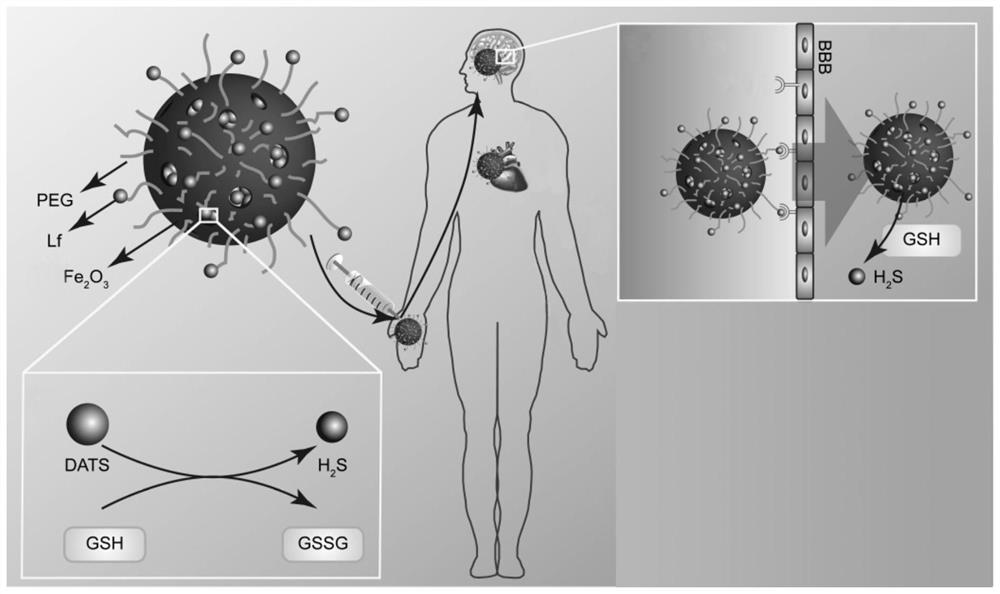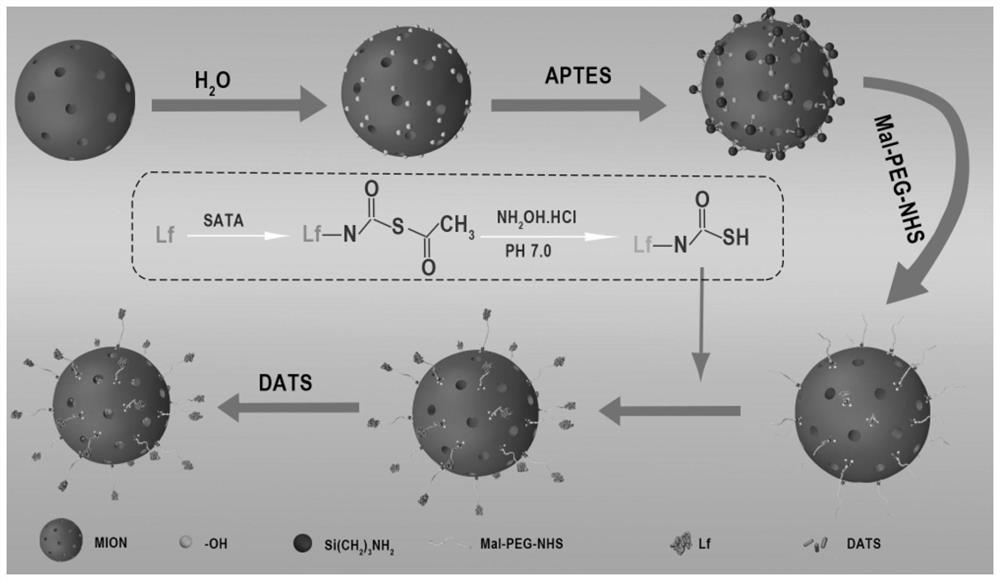Hydrogen sulfide controlled-release brain-targeted nano system for protecting nervous system after sudden cardiac arrest and preparation method thereof
A technology for nervous system protection and cardiac arrest, applied to nervous system diseases, medical preparations of non-active ingredients, pharmaceutical formulas, etc., can solve problems such as fast release speed, high concentration, and non-regulation
- Summary
- Abstract
- Description
- Claims
- Application Information
AI Technical Summary
Problems solved by technology
Method used
Image
Examples
Embodiment 1
[0040] Preparation of Mesoporous Iron Oxide Nanoparticle Materials (MIONs):
[0041]Add 36ml of polystyrene, 4ml of methacrylic acid and 140ml of deionized water into the three-necked flask, ultrasonically disperse, heat and stir at 75°C for 30 minutes, dissolve 0.4g of potassium persulfate in 40ml of deionized water, and slowly add the above In the three-neck flask, continue to react at 75°C for 24 hours to obtain polystyrene nanospheres. After cooling, add 1g polystyrene nanospheres, 170ml deionized water, and 30ml ethylene glycol to a new flask, and ultrasonically disperse; In addition, 0.446g of ferrous chloride, 0.111g of potassium nitrate and 2g of hexamethylenetetramine were respectively added to the aforementioned polypropylene nanosphere solution, and under the protection of nitrogen, the solution was heated to 80°C and reacted for 3 hours, and the solution was After gradually cooling to room temperature, centrifuge at 12000r for 10 minutes; the collected product was ...
Embodiment 2
[0048] In vitro safety test:
[0049] Routine method obtains primary neonatal mouse cortical neuron cell; Neuron cell (10 5 / mL) routinely use DMEM / F12 and 10% calf serum to culture in a carbon dioxide incubator (37°C, 5% CO 2 ) for 12 hours, add DATS@MION-PEG-LF (0-100μg / mL) to the 96-well plate where neuron cells were planted, replace the culture medium with CCK-8 solution and react for 24 hours, then measure the cell Activity (450nm).
[0050] In vivo safety experiment:
[0051] Routinely select 30 male Balb / c nude mice of similar age and weight, and randomly divide them into two groups, A and B. At the same time, inject 0.1ml of 1mmol / L DATS-MION solution into each nude mouse of group A by tail vein injection. Inject the same amount of 0.9% NaCl solution into each nude mouse of group B, raise the nude mice of A and B groups under the same ventilation, light, temperature, humidity and feeding conditions, and in the 7th, 14th and 21st days after the injection In the morn...
Embodiment 3D
[0053] The hydrogen sulfide release assessment of embodiment 3DATS@MION-PEG-LF
[0054] Release in vitro: Determination of hydrogen sulfide release by high-performance liquid chromatography (HPLC): DATS@MION-PEG-LF (10μg / mL), NaHS (10μM) and DATS (10μg / mL) Add 4mL of 100mM phosphate solution (PBS), then add 200μM GSH, and then measure hydrogen sulfide. When measuring, take 30μL of the sample and mix it with 70μL of Tris-HCl (100mM, pH 9.5, 0.1Mm DPTA), and then Mix with 50 μL monobromobimane solution, react for 30 minutes, add 50 μL glacial acetic acid (200 mM) to terminate the reaction, then take 100 μL supernatant and add it to the chromatographic column (XDB-C18column, 150*4.6mm, 5 μm) of the HPLC instrument (1260infinity), and detect by fluorescence method Hydrogen sulfide concentration (λex: 390nm and λem: 475nm), and compared with the standard curve, the detection time is 0 to 120 minutes.
[0055] In vivo release: SD rats (200-220 grams) were given DATS@MION-PEG-LF (10...
PUM
 Login to View More
Login to View More Abstract
Description
Claims
Application Information
 Login to View More
Login to View More - R&D
- Intellectual Property
- Life Sciences
- Materials
- Tech Scout
- Unparalleled Data Quality
- Higher Quality Content
- 60% Fewer Hallucinations
Browse by: Latest US Patents, China's latest patents, Technical Efficacy Thesaurus, Application Domain, Technology Topic, Popular Technical Reports.
© 2025 PatSnap. All rights reserved.Legal|Privacy policy|Modern Slavery Act Transparency Statement|Sitemap|About US| Contact US: help@patsnap.com



